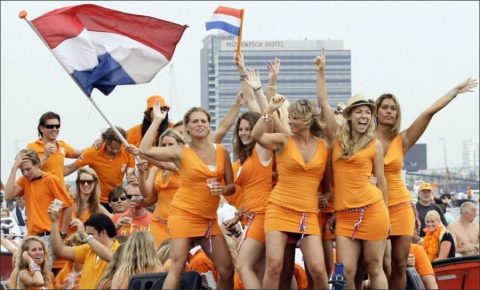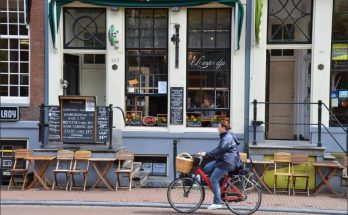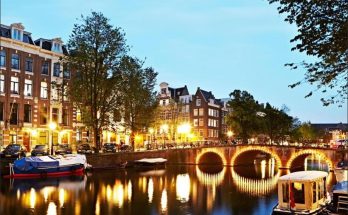A history of the Netherlands must first explain how and why a Netherland nation came into being. It seems strange that in a tiny corner of the great plain of northwest Europe, open to invasion from all sides, there should exist a nation quite distinct from its far more powerful neighbors. It is even more remarkable that this small nation has proved strong enough to maintain itself as a separate political entity and to carry its own civilization to the far corners of the earth.
The European territory of the kingdom of the Netherlands covers only 13,700 square miles, an area about equal to that of Massachusetts, Rhode Island, and Connecticut. The country derives its name from its geographic location: “Nederland” is the lowland as opposed to the “overland,” the high land of the interior.
Originally the term was used in a vague sense. Siegfried, the hero of the Nibelungen epic, is called the “helt von Niderland” by a German poet of the early XIIIth century. Here, “Niderland” stands for the great plain of the lower Rhine, which the poet distinguishes sharply from the mountainous area of the middle Rhine, the scene of his hero’s chief exploits. Gradually the meaning of, the term was restricted to the delta of Rhine, Meuse, and Scheldt, and in Dutch medieval chronicles these lands are referred to as the “low lands along the sea,” our “Low Countries.”
The medieval scribe who, around 1350, styled himself the “cleric from the low lands along the sea,” recognized as his fatherland only the country of Holland, a narrow strip of land from the mouth of the Scheldt to the Zuiderzee. Even a century later, the name applied solely to the western coastal provinces of Belgium and of the Netherlands. Flanders, Brabant, Holland, and Utrecht were included, but the northeastern districts from Guelders to Groningen were considered definitely foreign.
To the coastal inhabitants these districts were part of the “Overland” or “Oostland”–the great eastern plain between the Zuiderzee and the Oder–and their inhabitants spoke, not the vernacular “Dutch,” but a foreign tongue, the “Low Saxon” or “Overlandish.” In the XVIth century the union of the present states of the Netherlands and Belgium was realized. From then on, the name of “Netherlands” or “Low Countries” is applied to the whole of that area, and the latter term even now indicates the combined territory of both states. The name “Netherlands” was first used politically in 1539. As at that time most historians wrote in Latin, a classical form had to be devised.
The name “Belgica,” once applied by the Romans to the lands that lie between the Seine and the Rhine had remained in ecclesiastical use until late in the Middle Ages. Humanistic studies brought revived interest in the premedieval history of the northern countries and from Caesar’s narrative of his bitter battles with the “Belgae,” the name “Belgica” was re-introduced, to indicate the Low Countries.
In the century that saw the union of the “low lands” and the “overland” a religious and political conflict broke out and led to the separation of the northern from the southern half of the Low Countries. The northern section retained the historical name of the Netherlands. Latin writers gradually replaced the name “Belgica” by that of “Batavia,” introduced from Tacitus. For another two centuries the southern section remained officially nameless, but it received the political denomination “Belgium” after gaining its independence in 1830.
In both countries there was a tendency, however, to substitute the name of one province for that of the whole. During the Middle Ages in the southern section, the province of Flanders so exceeded the others in trade and wealth, that “Flemings” became for a while the common name of all traders from the Low Countries. Italian historians called the eighty-years’ war, the “guerra di Fiandra.” After the separation of the northern and southern Low Countries, “Flemings” remained the common term for all Dutch-speaking people in the southern part and during the XIXth century they adopted this name as their own.
In the northern section, the province of Holland far surpassed the others, especially in commerce and shipping. Thus the northern Netherlanders became known among foreign nations as “Hollanders,” and from abroad the term found its way into the Netherlands. Napoleon Bonaparte, whose geographical terminology was always loose, gave the title “King of Holland” to his brother Louis. Thereafter the name Holland was commonly used among Netherlanders themselves, but on the restoration of Dutch independence, the historical term Netherlands, in its traditional plural form, was revived for official use.
As has been said, the Netherlands have no geographical boundaries to the south or the east. There is little racial difference between the Netherlanders and their neighbors either on the continent or in Britain. The Dutch language holds an intermediate position between English and High German. In Friesland, a language is spoken that has close affinity to old Anglo-Saxon. In other districts the local dialect approaches the Low German of the adjacent provinces of Germany.
So the name Netherlands indicates that the- genesis of the Netherland nation must be sought in the districts bordering the sea, and that their political and cultural characteristics were gradually extended to the east. Accordingly, the first part of this book will retrace this initial development and dwell upon the basic elements that made it possible. The second part will show how the Netherland nation, once it had found adequate political organization, extended its cultural and commercial activities over a large part of the world. The third section will describe how this same nation ceased to be a great power, and even was temporarily deprived of its political independence. Finally, how it asserted its right to free national existence and resumed its historic role of mediator between western and central Europe and even between the Occident and the Orient.
Geographic terminology concerning the Netherlands tends to be confusing and consistency in the use of words is essential to any clear statement of historical development. In this book “Low Countries” will be applied only to the combined territory of the present kingdoms of the Netherlands and Belgium. The noun “Low Countries” badly needs an adjectival form, which unfortunately does not exist. The form “Lowland” seems the only possibility. The familiar adjective “Dutch” will never be used for the earlier period except to indicate the language of the western coastlands both of Belgium and of Holland.
After 1600 it may serve as a supplementary adjectival form to “Netherlands.” “Netherlands” noun and “Netherland” adjective refer always to the northern part of the Low Countries, that is to the present kingdom of the Netherlands. “Holland” indicates the province of Holland, never the whole of the Netherlands. The same is true of “Flanders” and.”Flemish.” These indicate the province of Flanders, except when used for the history of the last century. In the latter case they refer to the “Dutch” speaking people of the kingdom of Belgium.
“Batavia,” the Latin name for the Netherlands, was given in 1619 to the capital of the Dutch East Indian empire. To avoid confusion between the inhabitants of that city and the Netherlanders in Europe when referred to by their Latin name–as was usual at the time of the French revolutionthe form “Batavi” will be used for the Germanic tribe of Roman days and that of “Batave,” philologically more correct than “Batavian,” for the republic in Europe. “Batavian” always indicates a connection with the capital of the East Indies.



